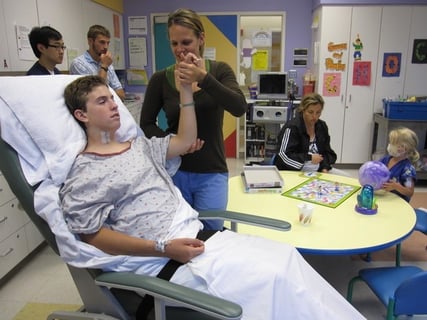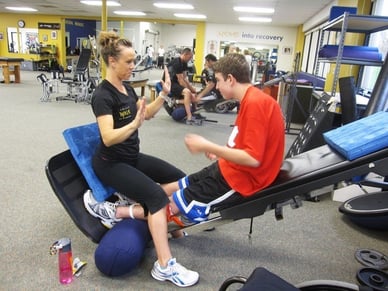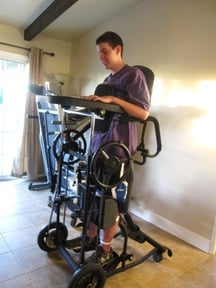Physical Therapy: Try It! - Reeve Foundation
By guest author Amber Collie
Everyone needs daily activity to keep our bodies functioning at a healthy level. Even more so as a paralyzed person. We take for granted the mundane activities we do without thinking, walking around the house, in and out of stores, shopping, running errands etc. add in a workout, jogging or just walking the dog. When you’re paralyzed, all of that stops, so you really have to make an even bigger effort to exercise your body and move muscles or they atrophy (shrink up). This is not an easy task.
My son became a quadriplegic in a beach accident when he was a teen. One of the first things done after leaving the intensive care unit and recovering from surgery in the hospital was physical therapy. At first, they would come into his room and move his arms & legs for him, then he would be transferred to a wheelchair and would do PT in the chair, barely able to sit up, needing a chest strap and a blood pressure belt. I remember the first time Zack went outside of the hospital. Thinking fresh air would be good for him, I asked if we could do PT outside. Hesitant but willing, his therapist said yes and we ended up right outside the cafeteria at some tables you normally eat at. To this day I see that exact spot and still pass it when visiting the hospital.
 In the beginning stages, the physical therapist or assistant did all of the moving and stretching of Zack’s body. At the time, I was only thinking about the horrible, life altering accident, so not much attention went into this activity. Zack had hardly any movement of his own, so he let them do the work for him. I was processing this whole nightmare, still in shock mode. I took photos throughout Zack’s injury. It felt morbid taking pictures in the intensive care unit, but being a photographer, my nature was to capture life’s moments, either good or bad. Plus, I wanted my 15-year-old son to have something to look back on as he slowly recovered. I wanted him to see the stages of recovery and just how far he had come. I don’t regret taking the pictures because that is exactly what they did for him. Zack got to see the progress of how far he had come.
In the beginning stages, the physical therapist or assistant did all of the moving and stretching of Zack’s body. At the time, I was only thinking about the horrible, life altering accident, so not much attention went into this activity. Zack had hardly any movement of his own, so he let them do the work for him. I was processing this whole nightmare, still in shock mode. I took photos throughout Zack’s injury. It felt morbid taking pictures in the intensive care unit, but being a photographer, my nature was to capture life’s moments, either good or bad. Plus, I wanted my 15-year-old son to have something to look back on as he slowly recovered. I wanted him to see the stages of recovery and just how far he had come. I don’t regret taking the pictures because that is exactly what they did for him. Zack got to see the progress of how far he had come.
Once out of the medical hospital he was transferred to a rehab hospital, the PT became a daily activity. Someone would come get him dressed, help him get out of bed using a Hoyer lift and into his wheelchair, wheeling off to therapy. I would follow along in a complete daze. The PT team was kind, cool, and encouraged Zack to move as much as he could. He also did Occupational Therapy (OT) which consisted of re-learning and attempting to do the daily things in everyday life such as picking up things, holding a cup, and brushing his teeth, none of which Zack could do at the time. So much mental strength was needed during this process (it still is) that it felt impossible to do even the simplest of tasks. It felt like a hit to the stomach every time I saw my boy try. It was heartbreaking to watch him try to pick up something with hands that no longer had any strength in them. I think there was a love/hate relationship with the OT pushing him to keep trying to do these usually simple tasks. Things that you didn't even think about doing before now were extremely frustrating and difficult.
Zack was in rehab hospital for close to three months, checking out the week of his 16th birthday. Leaving the hospital was a mixture of emotions. We couldn't wait to get home, but that would mean we would be on our own with no “nurse call button”. While in rehab we met three moms and their sons who were all three years post injury. They served as the best mental therapy and were full of helpful information. I asked so many questions and followed their paved path and advice.
 We live in southern California. I was told of a therapy place that was working with paralyzed people and were having good success, so we chose to drive an hour and twenty minutes each way, four days a week to go there, spending $100 an hour for three hours a day (that was approx. $350 a day, add in gas and food, yikes!). I was extremely focused on Zack gaining back any physical movement, so I didn't think of the vast amount of money that was going into these workouts.
We live in southern California. I was told of a therapy place that was working with paralyzed people and were having good success, so we chose to drive an hour and twenty minutes each way, four days a week to go there, spending $100 an hour for three hours a day (that was approx. $350 a day, add in gas and food, yikes!). I was extremely focused on Zack gaining back any physical movement, so I didn't think of the vast amount of money that was going into these workouts.
Our time at the new physical therapy place was not only good for Zack physically, but mentally too. “Rolling” into a place where everyone is paralyzed made us feel not alone. We saw people better off and worse off. We saw the progress of each other and celebrated the small victories. The support was really healthy for us. The financial part took over though and we had to cut down to attending three days, then two days, then one. Even at one day a week, we were still spending quite a lot of money monthly on workouts. I did some asking around and found a small one-on-one place half the distance, so we added that therapy in for a while ($50 hr.). By word of mouth, we found another place only roughly 25 minutes away. This place was set up just like a regular gym membership ($30 month) but the exercise equipment was all wheelchair accessible. We continued the one-on-one training for years. We even tried using an at-home physical therapy routine with a physical therapist ($50-$85 an hour) while utilizing Zack’s medical insurance (no charge), but the workouts were not as good.
 The great thing was that Zack’s body did not atrophy. To this day, almost 10 years post injury, he pretty much looks like an able-bodied young man sitting in a wheelchair, but we paid the price financially for sure! In hindsight, maybe I should have slowed down a bit with all the different therapies, but I had to feel like we tried everything we possibly could. I was surviving this injury, completely focused on his physical loss and gain. I couldn't accept that the diagnosis was final. Zack has overcome obstacles the doctors said he would not be able to overcome. An earlier acceptance would have saved us a lot of money though that we could have used elsewhere. We needed goals to keep us moving forward, setting small and large ones as we went along.
The great thing was that Zack’s body did not atrophy. To this day, almost 10 years post injury, he pretty much looks like an able-bodied young man sitting in a wheelchair, but we paid the price financially for sure! In hindsight, maybe I should have slowed down a bit with all the different therapies, but I had to feel like we tried everything we possibly could. I was surviving this injury, completely focused on his physical loss and gain. I couldn't accept that the diagnosis was final. Zack has overcome obstacles the doctors said he would not be able to overcome. An earlier acceptance would have saved us a lot of money though that we could have used elsewhere. We needed goals to keep us moving forward, setting small and large ones as we went along.
So overall, I do not regret trying all the different therapies, for each one taught us something new. Throughout the years, we met several injured people and families that are still our support system to this day. It took a few years for Zack to mature and to realize that he needed to give more effort to his workouts on his own and not to rely on the one on one. We now own a hand cycle and a standing frame. Just like able-bodied folks, it takes discipline and effort to workout. No one regrets doing the workout once you complete it and actually, you will feel great! It’s hard to get started but it's never too late, so start today!
Join Our Movement
What started as an idea has become a national movement. With your support, we can influence policy and inspire lasting change.
Become an Advocate